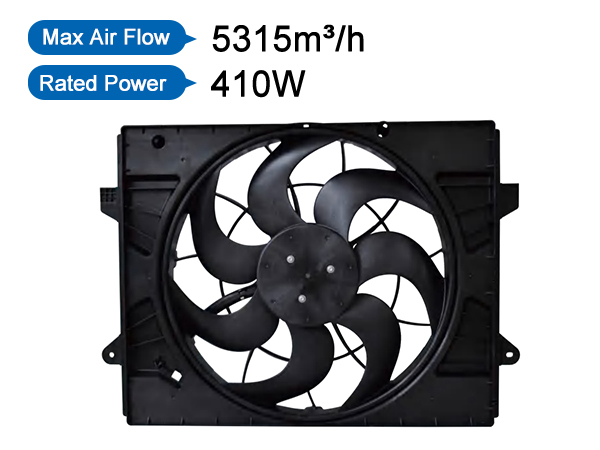Automotive Fan Noise Control Technology - Analyze the sources and control methods of noise
Published:2024-07-27
Automotive fan noise control is a complex issue that involves multiple disciplines and fields, requiring the integrated application of aerodynamics, acoustics, materials science, and electronic control technologies. By optimizing the design of fan blades, adopting low-noise motor technology, applying sound insulation and absorption materials, implementing active noise control, and developing intelligent control strategies, the noise of automotive fans can be significantly reduced, enhancing the comfort of driving and riding. This article will delve into the sources of automotive fan noise and discuss a series of effective control methods.

I. Analysis of the Sources of Automotive fan Noise
Mechanical Vibration Noise: When the fan blades rotate at high speeds, mechanical vibrations are generated due to issues such as material rigidity, imbalance, or installation precision, which then cause air disturbances and structural resonance, resulting in low-frequency noise.
Aerodynamic Noise: As the fan blades cut through the air, they produce complex airflow phenomena such as vortices and turbulence. These phenomena interact to form high-frequency noise, including rotational noise and vortex noise. Rotational noise is mainly caused by pressure fluctuations generated when the blades periodically pass through the same position, while vortex noise originates from the dissipation of turbulent energy during the separation and reattachment of the airflow.
Motor Noise: The motor that drives the fan is also a source of noise, including electromagnetic vibration noise, bearing noise, and the noise of cooling fans (if any).
Resonance Amplification: The vehicle's structural components (such as the dashboard, doors, etc.) can resonate with the fan noise at specific frequencies, further amplifying the noise level.
II. Methods for Controlling Automotive fan Noise
Optimizing Fan Blade Design:
Aerodynamic Optimization: Through CFD (Computational Fluid Dynamics) simulation analysis, the shape, angle, and arrangement of the blades are optimized to reduce airflow separation and turbulence, thereby reducing aerodynamic noise.
Dynamic Balancing: Fan blades undergo rigorous dynamic balancing tests and adjustments to ensure the best balance state during rotation, reducing mechanical vibration noise.
Adopting Low-Noise Motor Technology:
Selecting high-precision bearings to reduce bearing friction noise.
Using brushless DC motors or permanent magnet synchronous motors to reduce electromagnetic vibration and noise.
When integrating motor cooling systems, choosing low-noise fans or adopting other efficient heat dissipation solutions.
Application of Sound Insulation and Absorption Materials:
Applying sound insulation materials, such as foam, rubber, or special composite materials, around the fan and its surrounding structural components to block noise transmission paths.
Arranging sound absorption materials, such as sound-absorbing cotton and micro-perforated panels, inside the vehicle to absorb and convert noise energy into heat energy, reducing noise reflection and resonance.
Active Noise Control Technology:
Utilizing a speaker system to generate sound waves that are out of phase with the fan noise, achieving sound wave cancellation and thus reducing the noise level inside the vehicle. This method is particularly suitable for controlling low-frequency noise.
Intelligent Control Strategies:
Automatically adjusting the fan speed according to the vehicle's operating conditions (such as vehicle speed, engine load) to avoid unnecessary high-speed operation and reduce noise generation.
Integrating into the overall vehicle control system to achieve coordinated operation of the fan with other cooling systems (such as water cooling systems), optimizing the balance between cooling efficiency and noise control.
- Distribution in Water Heater Mattresses: Why BLDC Pumps Ensure Uniform Heating
- How BLDC Pumps Ensure Precise Flow in Water Dispensers
- Why BLDC Pumps Are Essential for Smart Toilets
- The Critical Role of Automotive Electronic Water Pumps in New Energy Vehicle Battery Thermal Management
- Noise Control Technology for Smart Toilet Water Pumps: Enhancing Quiet Operation in Modern Bathrooms
- Unveiling the Working Principle of Automotive Electronic Water Valves
- Comparative Analysis of Liquid-Cooled Pumps vs. Air-Cooled Systems for EV Charging Stations
- Technical Application of Brushless DC Motors in Energy Storage Circulation Pumps
- Water Heater Pump: Efficiency Upgrade for Low-Voltage Systems
- How Dishwasher Water Pumps Enhance Cleaning Coverage Through Stable Operation?
